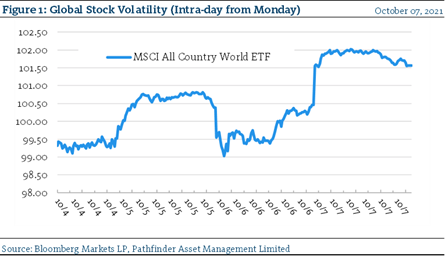United States Debt Ceiling
Earlier this week, during one of our morning desk calls, the question are any portfolio managers concerned enough about the United States debt ceiling issue to make adjustments to the portfolios for risk mitigation (i.e. sell stock positions to raise cash). If you have been watching the markets over the past couple of weeks, you would have noticed some volatility (in all assets classes). Part of the financial press’ explanation for the volatility has been inflation, the energy crisis and the US Debt ceiling. This is classic behavioral finance. The press likes to point to a simple reason to explain a complex system and thus, for example, made a big deal about the debt ceiling as a reason for downside volatility.
The US is the only major developed economy in the world that has legislated the maximum amount of debt that the government can issue. Every other country just issues debt to pay for its bills without any fanfare. The US, effectively, does the same and, its constitution (14th Amendment) makes it illegal for the government not to pay its bills. But, from time to time, the politicians (usually the Republicans when Democrats are in power) like delaying legislation to make a big show about how fiscally responsible they claim to be.

To be sure, defaulting on the US debt would be a calamity. First, it would force every US money market fund to sell all of their US Treasury positions. These funds are not allowed to own short-term paper that are in default. Next, it would impact the repo market (multi-trillions), which is where global banks and large financial institutions use US government debt as collateral to fund overnight liquidity to keep their businesses running for the next day. Then, essentially every pension fund in the US (multi-trillions again) would have to sell their US bonds because a default would result in a substantial credit downgrade for the US Government and many of these funds have minimum credit quality requirements for their bond portfolios. In short, it would make the Great Financial Recession of 2008 look like a “minor blip”, which is why, for the life if me, I cannot understand why politicians would play this kind of game. It truly is a game because the debt ceiling has been raised at least 178 times since it was created in 1917 (my count) and most times we never hear about it.
“This means that” while we maintain a close watch on these types of macro developments, it is very rare that they actually come to influence the market in a way that is reliably predictable. We instead focus the vast majority of our time and energy searching for good, well-run, companies that are hopefully mispriced by the market. If we can find a company that will pay us a growing cash flow stream at a cheap price, then we think that that is far more valuable than trying to guess how other investors and speculators will react to something alarming that US politicians may or may not do.
National Instrument 31-103 requires registered firms to disclose information that a reasonable investor would expect to know, including any material conflicts with the firm or its representatives. Doug Johnson and/or Pathfinder Asset Management Limited are an insider of companies periodically mentioned in this report. Please visit www.paml.ca for full disclosures.
*All returns are time weighted and net of investment management fees. Returns from the Pathfinder Partners’ Fund and Partners’ Real Return Plus Fund are presented based on the masters series of each fund. The Pathfinder Core: Equity Portfolio and The Pathfinder Core: High Income Portfolio are live accounts. These are actual accounts owned by the Pathfinder Chairman (Equity) and client (High Income) which contain no legacy positions, cash flows or other Pathfinder investment mandates or products. Monthly inception dates for each fund and portfolio are as follows: Pathfinder Core: Equity Portfolio (January 2011), Pathfinder Core: High Income Portfolio (October 2012) Partners’ Fund (April 2011), Partners’ Real Return Plus Fund (April, 2013), and Partners’ Core Plus Fund (November 2014).
Pathfinder Asset Management Limited (PAML) and its affiliates may collectively beneficially own in excess of 10% of one or more classes of the issued and outstanding equity securities mentioned in this newsletter. This publication is intended only to convey information. It is not to be construed as an investment guide or as an offer or solicitation of an offer to buy or sell any of the securities mentioned in it. The author has taken all usual and reasonable precautions to determine that the information contained in this publication has been obtained from sources believed to be reliable and that the procedures used to summarize and analyze such information are based on approved practices and principles in the investment industry. However, the market forces underlying investment value are subject to sudden and dramatic changes and data availability varies from one moment to the next. Consequently, neither the author nor PAML can make any warranty as to the accuracy or completeness of information, analysis or views contained in this publication or their usefulness or suitability in any particular circumstance. You should not undertake any investment or portfolio assessment or other transaction on the basis of this publication, but should first consult your portfolio manager, who can assess all relevant particulars of any proposed investment or transaction. PAML and the author accept no liability of any kind whatsoever or any damages or losses incurred by you as a result of reliance upon or use of this publication.